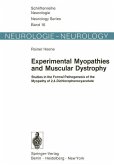Turgut Tatlisumak / Marc Fisher (eds.)
Handbook of Experimental Neurology
Herausgeber: Tatlisumak, Turgut; Fisher, Marc
Turgut Tatlisumak / Marc Fisher (eds.)
Handbook of Experimental Neurology
Herausgeber: Tatlisumak, Turgut; Fisher, Marc
- Gebundenes Buch
- Merkliste
- Auf die Merkliste
- Bewerten Bewerten
- Teilen
- Produkt teilen
- Produkterinnerung
- Produkterinnerung
An essential 2006 reference volume covering major methodologies and disease models in current neuroscience research.
Andere Kunden interessierten sich auch für
![Botulism: a Clinical and Experimental Study Botulism: a Clinical and Experimental Study]() Ernest Charles DicksonBotulism: a Clinical and Experimental Study35,99 €
Ernest Charles DicksonBotulism: a Clinical and Experimental Study35,99 €![Journal of Experimental Medicine 1938-06 Journal of Experimental Medicine 1938-06]() AnonymousJournal of Experimental Medicine 1938-0635,99 €
AnonymousJournal of Experimental Medicine 1938-0635,99 €![The Mental Traits of Sex: An Experimental Investigation of the Normal Mind in Men and Women The Mental Traits of Sex: An Experimental Investigation of the Normal Mind in Men and Women]() Helen Bradford Thompson WoolleyThe Mental Traits of Sex: An Experimental Investigation of the Normal Mind in Men and Women36,99 €
Helen Bradford Thompson WoolleyThe Mental Traits of Sex: An Experimental Investigation of the Normal Mind in Men and Women36,99 €![Experimental Myopathies and Muscular Dystrophy Experimental Myopathies and Muscular Dystrophy]() R. HeeneExperimental Myopathies and Muscular Dystrophy83,99 €
R. HeeneExperimental Myopathies and Muscular Dystrophy83,99 €![Numerical and experimental investigation of Ti/HA FGM dental implant Numerical and experimental investigation of Ti/HA FGM dental implant]() Sina SazeshNumerical and experimental investigation of Ti/HA FGM dental implant36,99 €
Sina SazeshNumerical and experimental investigation of Ti/HA FGM dental implant36,99 €![Experimental Investigation of the Action of Medicines Experimental Investigation of the Action of Medicines]() Thomas Lauder BruntonExperimental Investigation of the Action of Medicines33,99 €
Thomas Lauder BruntonExperimental Investigation of the Action of Medicines33,99 €![An Introduction to the Study of Experimental Medicine / Translated by H.C. Greene An Introduction to the Study of Experimental Medicine / Translated by H.C. Greene]() Claude BernardAn Introduction to the Study of Experimental Medicine / Translated by H.C. Greene38,99 €
Claude BernardAn Introduction to the Study of Experimental Medicine / Translated by H.C. Greene38,99 €-
-
-
An essential 2006 reference volume covering major methodologies and disease models in current neuroscience research.
Hinweis: Dieser Artikel kann nur an eine deutsche Lieferadresse ausgeliefert werden.
Hinweis: Dieser Artikel kann nur an eine deutsche Lieferadresse ausgeliefert werden.
Produktdetails
- Produktdetails
- Verlag: Cambridge University Press
- Seitenzahl: 594
- Erscheinungstermin: 5. Oktober 2006
- Englisch
- Abmessung: 250mm x 175mm x 36mm
- Gewicht: 1190g
- ISBN-13: 9780521838146
- ISBN-10: 0521838142
- Artikelnr.: 22197646
- Herstellerkennzeichnung
- Produktsicherheitsverantwortliche/r
- Europaallee 1
- 36244 Bad Hersfeld
- gpsr@libri.de
- Verlag: Cambridge University Press
- Seitenzahl: 594
- Erscheinungstermin: 5. Oktober 2006
- Englisch
- Abmessung: 250mm x 175mm x 36mm
- Gewicht: 1190g
- ISBN-13: 9780521838146
- ISBN-10: 0521838142
- Artikelnr.: 22197646
- Herstellerkennzeichnung
- Produktsicherheitsverantwortliche/r
- Europaallee 1
- 36244 Bad Hersfeld
- gpsr@libri.de
TurgutTatlisumak received his neurology training in the Helsinki University Central Hospital. He made his PhD thesis work on experimental brain ischemia and magnetic resonance imaging at the University of Massachusetts. His research field is clinical and experimental stroke and magnetic resonance imaging. He holds board certificates in neurology and health care administration in Finland. He is currently an associate professor and the Vice Chair at the Department of Neurology, Helsinki University Central Hospital and the director of the Experimental Magnetic Resonance Imaging Laboratory. Dr. Tatlisumak is a Fellow of the American Heart Association. He is an awarded teacher and holds a degree in teaching sciences.
Marc Fisher received his medical from the SUNY at Syracuse and then trained in medicine at the University of Wisconsin and neurology at the Medical Center of Vermont. He has been at the University of Massachusetts Medical School since 1978 and currently holds the position of Professor and Vice-Chairman in the neurology department. He performs clinical activities approximately 50% of the time with a special emphasis on patients with cerebrovascular disorders and multiple sclerosis. He has directed an animal stroke research laboratory for more than 15 years that has emphasized the use of novel MRI techniques to evaluate stroke evolution and to assess therapeutic interventions in vivo. He has participated in many clinical stroke trials as a member of the steering committee. He has published extensively in both of these areas with 156 peer reviewed publications and has edited 10 textbooks. He has worked closely with the pharmaceutical industry in the development of novel stroke therapies as well as designing and implementing clinical trials for acute stroke therapies.
Marc Fisher received his medical from the SUNY at Syracuse and then trained in medicine at the University of Wisconsin and neurology at the Medical Center of Vermont. He has been at the University of Massachusetts Medical School since 1978 and currently holds the position of Professor and Vice-Chairman in the neurology department. He performs clinical activities approximately 50% of the time with a special emphasis on patients with cerebrovascular disorders and multiple sclerosis. He has directed an animal stroke research laboratory for more than 15 years that has emphasized the use of novel MRI techniques to evaluate stroke evolution and to assess therapeutic interventions in vivo. He has participated in many clinical stroke trials as a member of the steering committee. He has published extensively in both of these areas with 156 peer reviewed publications and has edited 10 textbooks. He has worked closely with the pharmaceutical industry in the development of novel stroke therapies as well as designing and implementing clinical trials for acute stroke therapies.
Preface; Part I. Principles and General Methods: 1. Introduction: Animal
modelling - a precious tool for developing remedies to neurological
diseases Turgut Tatlisumak and Marc Fisher; 2. Ethical issues, welfare
laws, and regulations David Whittaker; 3. Housing, feeding, and maintenance
of rodents Robert W. Kemp; 4. Identification of individual animals Turgut
Tatlisumak and Daniel Strbian; 5. Analgesia, anesthesia, and postoperative
care in laboratory animals Naoya Masutomi and Makoto Shibutani; 6.
Euthanasia in small animals Turgut Tatlisumak; 7. Various surgical
procedures in rodents René Remie; 8. Genetically engineered animals
Carolina M. Maier, Lilly Hsieh and Pak H. Chan; 9. Imaging in experimental
neurology Marc Fisher, Eng H. Lo and Michael Lev; 10. Safety in animal
facilities Tarja Kohila; 11. Behavioural testing in small animal models:
ischemic stroke Larry B. Goldstein; 12. Methods for analysing brain tissue
Päivi Liesi; 13. Targeting molecular constructs of cellular function and
injury through in vitro and in vivo experimental models Zhao Zhong Chong,
Faqi Li and Kenneth Maiese; 14. Neuroimmunology and immune-related
neuropathologies Bao-Guo Xiao and Hans Link; 15. Animal models of sex
differences in non-reproductive brain functions George T. Taylor, Juergen
Weiss and Frank Zimmermann; 16. The ependymal route for central nervous
system gene therapy Erica Butti, Gianvito Martino and Roberto Furlan; 17.
Neural transplantation Stephen B Dunnett, Eduardo M. Torres, Monte A.
Gates, and Rosemary A. Fricker-Gates; Part II. Experimental Models of Major
Neurological Diseases: 18. Focal brain ischemia models in rodents Fuhai Li
and Turgut Tatlisumak; 19. Rodent models of global brain ischemia Julia
Kofler and Richard J. Traystman; 20. Rodent models of hemorrhagic stroke
Fatima A. Sehba and Joshua B. Bederson; 21. In-vivo models of traumatic
brain injury Ronen R Leker and Shlomi Constantini; 22. Experimental models
for the study of CNS tumors Taichang Jang and Lawrence Recht; 23.
Experimental models for demyelinating diseases Jason M Link, Richard E.
Jones, Halina Offner and Arthur A Vandenbark; 24. Animal models of
Parkinson's disease Anumantha G. Kathasamy and Siddharth Kaul; 25. Animal
models of epilepsy Ricardo M. Arida, Alexandre V. Silva, Margareth R.
Priel, and Esper A. Cavalheiro; 26. Experimental models of hydrocephalus
Osaama H. Khan and Marc R. Del Bigio; 27. Rodent models of experimental
bacterial infections in the CNS Tammy Kielian; 28. Experimental models of
motor neuron disease Ruth Danzeisen, Birgit Schwalenstöcker and Albert C
Ludolph; 29. Animal models for sleep disorders Seiji Nishino and Nobuhiro
Fujiki; 30. Experimental models of muscle diseases Anu Suomalainen, Katja
E. Peltola, Anders Paetau and Carina Wallgren-Pettersson.
modelling - a precious tool for developing remedies to neurological
diseases Turgut Tatlisumak and Marc Fisher; 2. Ethical issues, welfare
laws, and regulations David Whittaker; 3. Housing, feeding, and maintenance
of rodents Robert W. Kemp; 4. Identification of individual animals Turgut
Tatlisumak and Daniel Strbian; 5. Analgesia, anesthesia, and postoperative
care in laboratory animals Naoya Masutomi and Makoto Shibutani; 6.
Euthanasia in small animals Turgut Tatlisumak; 7. Various surgical
procedures in rodents René Remie; 8. Genetically engineered animals
Carolina M. Maier, Lilly Hsieh and Pak H. Chan; 9. Imaging in experimental
neurology Marc Fisher, Eng H. Lo and Michael Lev; 10. Safety in animal
facilities Tarja Kohila; 11. Behavioural testing in small animal models:
ischemic stroke Larry B. Goldstein; 12. Methods for analysing brain tissue
Päivi Liesi; 13. Targeting molecular constructs of cellular function and
injury through in vitro and in vivo experimental models Zhao Zhong Chong,
Faqi Li and Kenneth Maiese; 14. Neuroimmunology and immune-related
neuropathologies Bao-Guo Xiao and Hans Link; 15. Animal models of sex
differences in non-reproductive brain functions George T. Taylor, Juergen
Weiss and Frank Zimmermann; 16. The ependymal route for central nervous
system gene therapy Erica Butti, Gianvito Martino and Roberto Furlan; 17.
Neural transplantation Stephen B Dunnett, Eduardo M. Torres, Monte A.
Gates, and Rosemary A. Fricker-Gates; Part II. Experimental Models of Major
Neurological Diseases: 18. Focal brain ischemia models in rodents Fuhai Li
and Turgut Tatlisumak; 19. Rodent models of global brain ischemia Julia
Kofler and Richard J. Traystman; 20. Rodent models of hemorrhagic stroke
Fatima A. Sehba and Joshua B. Bederson; 21. In-vivo models of traumatic
brain injury Ronen R Leker and Shlomi Constantini; 22. Experimental models
for the study of CNS tumors Taichang Jang and Lawrence Recht; 23.
Experimental models for demyelinating diseases Jason M Link, Richard E.
Jones, Halina Offner and Arthur A Vandenbark; 24. Animal models of
Parkinson's disease Anumantha G. Kathasamy and Siddharth Kaul; 25. Animal
models of epilepsy Ricardo M. Arida, Alexandre V. Silva, Margareth R.
Priel, and Esper A. Cavalheiro; 26. Experimental models of hydrocephalus
Osaama H. Khan and Marc R. Del Bigio; 27. Rodent models of experimental
bacterial infections in the CNS Tammy Kielian; 28. Experimental models of
motor neuron disease Ruth Danzeisen, Birgit Schwalenstöcker and Albert C
Ludolph; 29. Animal models for sleep disorders Seiji Nishino and Nobuhiro
Fujiki; 30. Experimental models of muscle diseases Anu Suomalainen, Katja
E. Peltola, Anders Paetau and Carina Wallgren-Pettersson.
Preface; Part I. Principles and General Methods: 1. Introduction: Animal
modelling - a precious tool for developing remedies to neurological
diseases Turgut Tatlisumak and Marc Fisher; 2. Ethical issues, welfare
laws, and regulations David Whittaker; 3. Housing, feeding, and maintenance
of rodents Robert W. Kemp; 4. Identification of individual animals Turgut
Tatlisumak and Daniel Strbian; 5. Analgesia, anesthesia, and postoperative
care in laboratory animals Naoya Masutomi and Makoto Shibutani; 6.
Euthanasia in small animals Turgut Tatlisumak; 7. Various surgical
procedures in rodents René Remie; 8. Genetically engineered animals
Carolina M. Maier, Lilly Hsieh and Pak H. Chan; 9. Imaging in experimental
neurology Marc Fisher, Eng H. Lo and Michael Lev; 10. Safety in animal
facilities Tarja Kohila; 11. Behavioural testing in small animal models:
ischemic stroke Larry B. Goldstein; 12. Methods for analysing brain tissue
Päivi Liesi; 13. Targeting molecular constructs of cellular function and
injury through in vitro and in vivo experimental models Zhao Zhong Chong,
Faqi Li and Kenneth Maiese; 14. Neuroimmunology and immune-related
neuropathologies Bao-Guo Xiao and Hans Link; 15. Animal models of sex
differences in non-reproductive brain functions George T. Taylor, Juergen
Weiss and Frank Zimmermann; 16. The ependymal route for central nervous
system gene therapy Erica Butti, Gianvito Martino and Roberto Furlan; 17.
Neural transplantation Stephen B Dunnett, Eduardo M. Torres, Monte A.
Gates, and Rosemary A. Fricker-Gates; Part II. Experimental Models of Major
Neurological Diseases: 18. Focal brain ischemia models in rodents Fuhai Li
and Turgut Tatlisumak; 19. Rodent models of global brain ischemia Julia
Kofler and Richard J. Traystman; 20. Rodent models of hemorrhagic stroke
Fatima A. Sehba and Joshua B. Bederson; 21. In-vivo models of traumatic
brain injury Ronen R Leker and Shlomi Constantini; 22. Experimental models
for the study of CNS tumors Taichang Jang and Lawrence Recht; 23.
Experimental models for demyelinating diseases Jason M Link, Richard E.
Jones, Halina Offner and Arthur A Vandenbark; 24. Animal models of
Parkinson's disease Anumantha G. Kathasamy and Siddharth Kaul; 25. Animal
models of epilepsy Ricardo M. Arida, Alexandre V. Silva, Margareth R.
Priel, and Esper A. Cavalheiro; 26. Experimental models of hydrocephalus
Osaama H. Khan and Marc R. Del Bigio; 27. Rodent models of experimental
bacterial infections in the CNS Tammy Kielian; 28. Experimental models of
motor neuron disease Ruth Danzeisen, Birgit Schwalenstöcker and Albert C
Ludolph; 29. Animal models for sleep disorders Seiji Nishino and Nobuhiro
Fujiki; 30. Experimental models of muscle diseases Anu Suomalainen, Katja
E. Peltola, Anders Paetau and Carina Wallgren-Pettersson.
modelling - a precious tool for developing remedies to neurological
diseases Turgut Tatlisumak and Marc Fisher; 2. Ethical issues, welfare
laws, and regulations David Whittaker; 3. Housing, feeding, and maintenance
of rodents Robert W. Kemp; 4. Identification of individual animals Turgut
Tatlisumak and Daniel Strbian; 5. Analgesia, anesthesia, and postoperative
care in laboratory animals Naoya Masutomi and Makoto Shibutani; 6.
Euthanasia in small animals Turgut Tatlisumak; 7. Various surgical
procedures in rodents René Remie; 8. Genetically engineered animals
Carolina M. Maier, Lilly Hsieh and Pak H. Chan; 9. Imaging in experimental
neurology Marc Fisher, Eng H. Lo and Michael Lev; 10. Safety in animal
facilities Tarja Kohila; 11. Behavioural testing in small animal models:
ischemic stroke Larry B. Goldstein; 12. Methods for analysing brain tissue
Päivi Liesi; 13. Targeting molecular constructs of cellular function and
injury through in vitro and in vivo experimental models Zhao Zhong Chong,
Faqi Li and Kenneth Maiese; 14. Neuroimmunology and immune-related
neuropathologies Bao-Guo Xiao and Hans Link; 15. Animal models of sex
differences in non-reproductive brain functions George T. Taylor, Juergen
Weiss and Frank Zimmermann; 16. The ependymal route for central nervous
system gene therapy Erica Butti, Gianvito Martino and Roberto Furlan; 17.
Neural transplantation Stephen B Dunnett, Eduardo M. Torres, Monte A.
Gates, and Rosemary A. Fricker-Gates; Part II. Experimental Models of Major
Neurological Diseases: 18. Focal brain ischemia models in rodents Fuhai Li
and Turgut Tatlisumak; 19. Rodent models of global brain ischemia Julia
Kofler and Richard J. Traystman; 20. Rodent models of hemorrhagic stroke
Fatima A. Sehba and Joshua B. Bederson; 21. In-vivo models of traumatic
brain injury Ronen R Leker and Shlomi Constantini; 22. Experimental models
for the study of CNS tumors Taichang Jang and Lawrence Recht; 23.
Experimental models for demyelinating diseases Jason M Link, Richard E.
Jones, Halina Offner and Arthur A Vandenbark; 24. Animal models of
Parkinson's disease Anumantha G. Kathasamy and Siddharth Kaul; 25. Animal
models of epilepsy Ricardo M. Arida, Alexandre V. Silva, Margareth R.
Priel, and Esper A. Cavalheiro; 26. Experimental models of hydrocephalus
Osaama H. Khan and Marc R. Del Bigio; 27. Rodent models of experimental
bacterial infections in the CNS Tammy Kielian; 28. Experimental models of
motor neuron disease Ruth Danzeisen, Birgit Schwalenstöcker and Albert C
Ludolph; 29. Animal models for sleep disorders Seiji Nishino and Nobuhiro
Fujiki; 30. Experimental models of muscle diseases Anu Suomalainen, Katja
E. Peltola, Anders Paetau and Carina Wallgren-Pettersson.








